One of my earliest memories of hearing bird sounds is my recollection of the hauntingly familiar song of the mourning dove Zenaida macroura. As a child, I grew up riding my bike around the streets of White Plains, New York and I often remember seeing these birds at the park and perching on telephone wires. As an adult and as an avid bird watcher, I have observed these birds quite frequently. This entails watching them while they are sunning themselves in trees, foraging for food on the ground or at the feeders, and sometimes watching their often not-so-graceful flight in the air. Although I have observed these birds quite often, I have to admit they are not on my top list of must-sees. What I can appreciate and from what I have observed is the fact they seem to form a sort of keen social structure and pairs have been known to be generally monogamous. I rarely observe solitary mourning doves. They are either in pairs or flocks. I also believe these birds hold deep symbolic meaning for some individuals and cultures. I would like to explore this symbolism as well as share some interesting facts and information about the mourning dove.
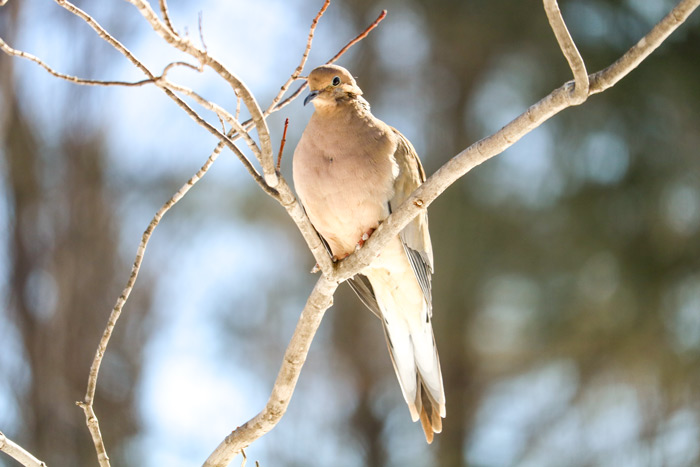
A perching mourning dove.
Mourning Dove Facts
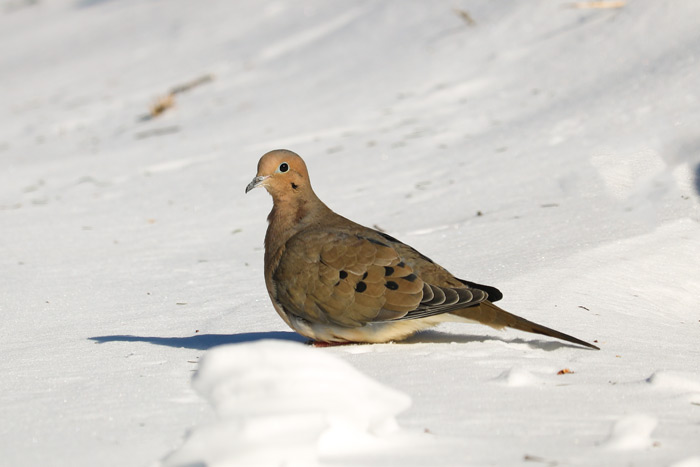
A mourning dove sitting in the snow.
Mourning Dove Symbolism
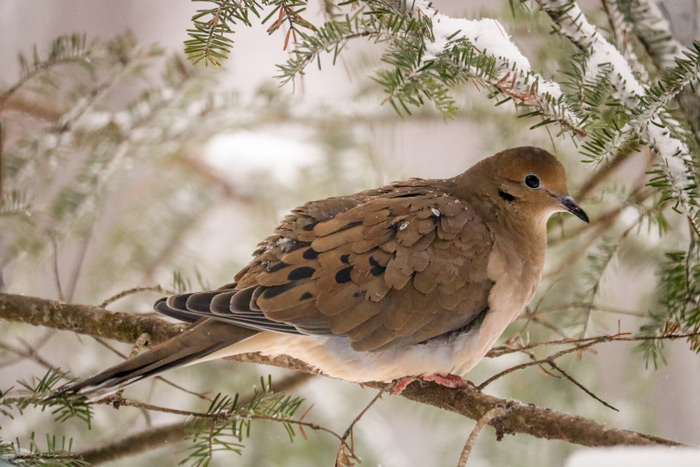
Symbolically, the mourning dove can be associated with mourning and sorrow, these birds can be viewed as both spiritual as well as hopeful. Although the white dove is regarded as a universal symbol of peace in the world, the mourning dove also represents the same. In some cultures, the mourning dove stands for new beginnings, and great expectations, and as a spiritual messenger. The roles of these birds may include helping us to find inner peace and go about our lives calmly and with purpose. The states of Wisconsin and Michigan consider the mourning dove as their official state symbol of peace. It is also the national bird of the British Virgin Islands.
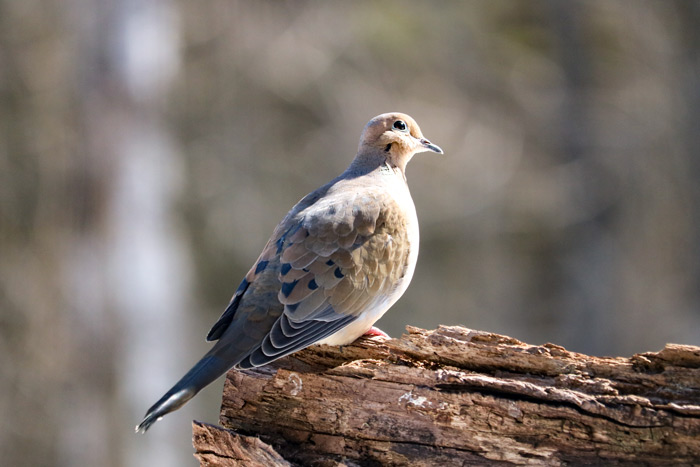
Mourning Dove Description
The mourning dove is plump-bodied with a head that seems small in comparison to their bodies. These birds have small bills and short legs. The tail is long and pointed. They are a delicate brown to a gray-buff color all over with a pinkish color below. There are black spots on the wings and the outer tail feathers are white, contrasting with the black inner feathers. Adult males have bright purple-pink patches on the neck and sides, with light pink coloring reaching the breast. The crown of the adult male is also a distinct bluish-grey color.
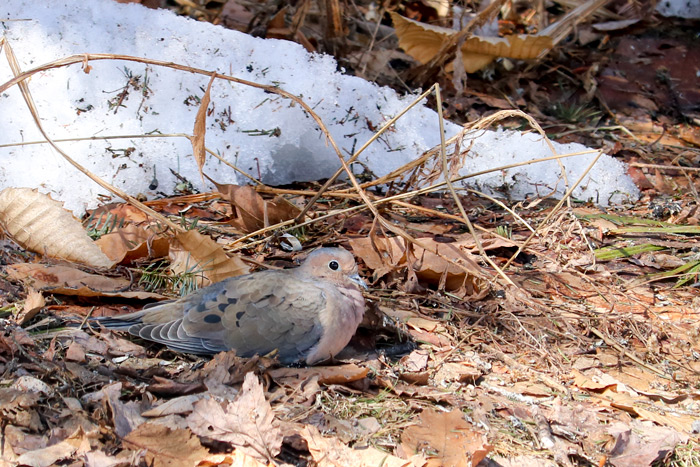
With the coloring of these birds, they blend into their surroundings quite well.
Mourning Dove Mating Call
The call of the mourning dove is a distinctive cooOOoo-woo-woo-woooo, by males to attract a mate. Other sounds include a nest call of cooOOoo by paired males to attract mates to a nesting site. The song consists of a perch-coo that is given mainly by males, that are unmated from a visible perch.
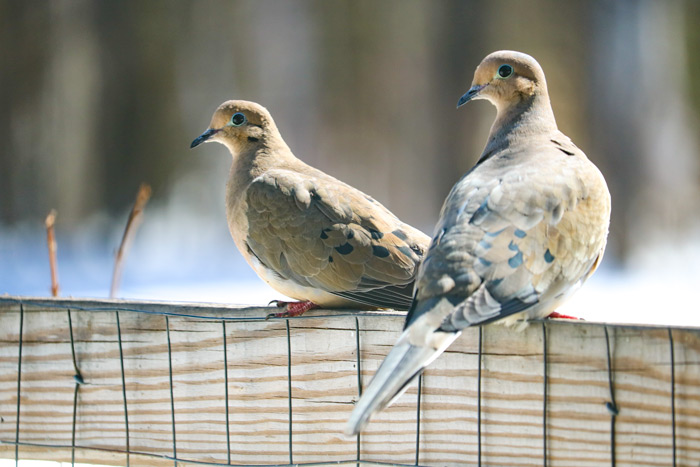
Two perching mourning doves.
Mourning Dove Sounds
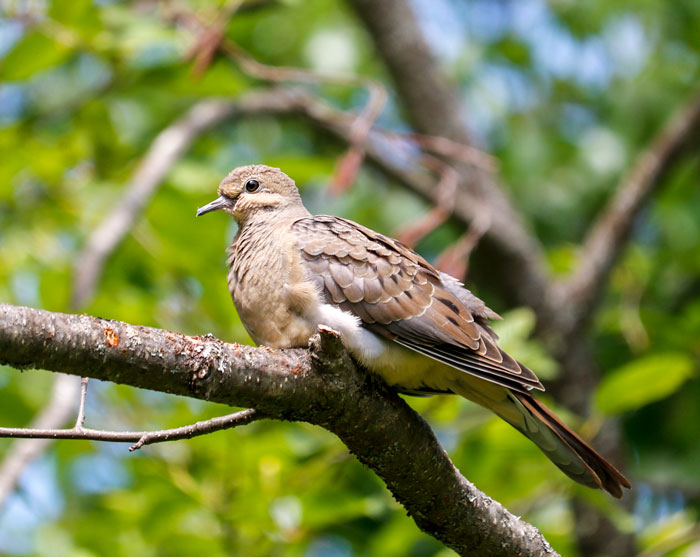
There is also a greeting call that consists of a soft ork by males when they rejoin their mates and an alarm call that consists of a short roo-oo by either male or female when threatened.
In flight, the wings of the mourning dove make a fluttery whistling sound that may be difficult to hear. The wing whistle is much louder and more noticeable upon the take-off and landing of these birds.
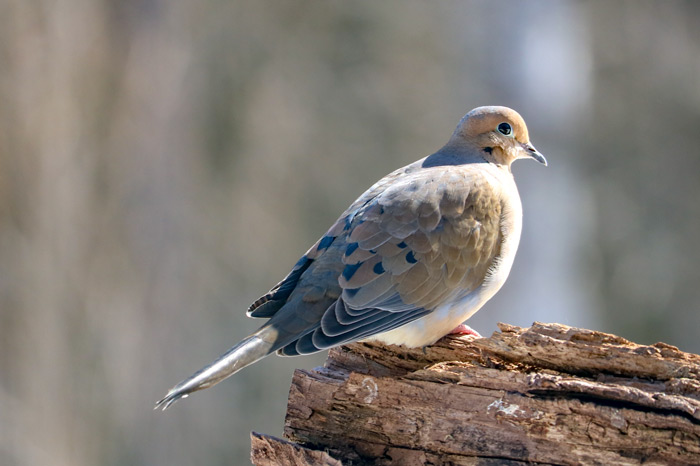
A mourning dove perched on a log.
Mourning Dove Food
Almost ninety-nine percent of the mourning dove’s diet consists of seeds. These birds favor cultivated grains and even peanuts, as well as wild grasses, weeds, herbs, many other plants, and occasionally berries. They will also sometimes eat snails.
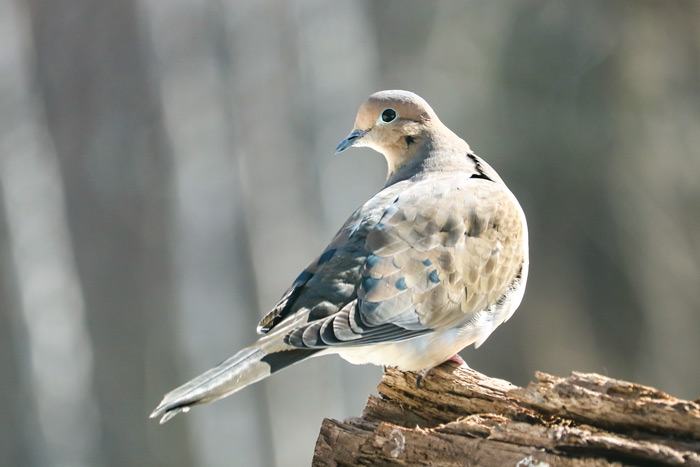
A mourning dove with its back turned to the camera.
Mourning Dove Nest
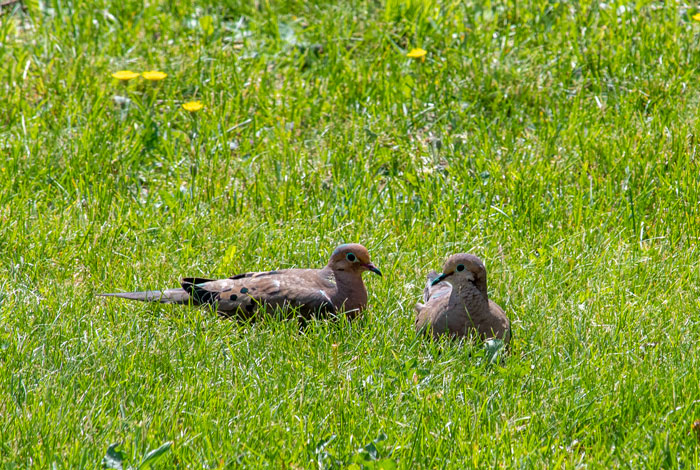
Courtship will begin with a noisy flight by the male mourning dove, followed by a graceful, circular glide with outstretched wings and the head down. Regarding nesting, the male will lead the female to the site. The female will choose a site and build it. The male will help in bringing the materials. The nesting site is usually constructed in deciduous and coniferous trees, or shrubs, on the ground, or sometimes on the ledge of a building or another type of structure. The nest is a flimsy platform made up of twigs.
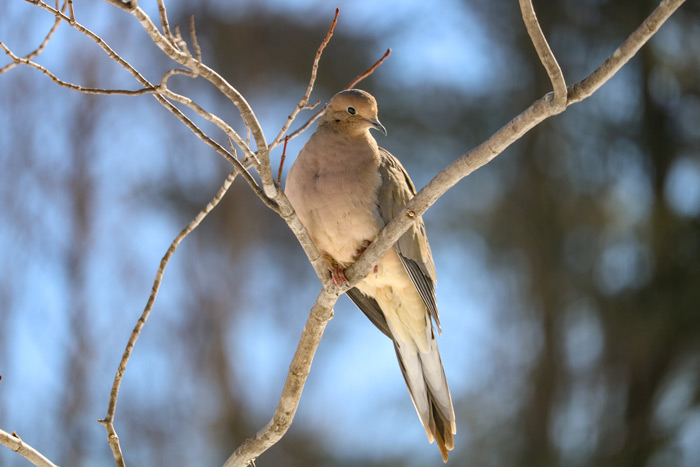
A mourning dove looking down.
Mourning Dove Young
Two white eggs are incubated by both of the parents. The young are also fed crop milk and regarding pigeons and doves, this is called “pigeon milk.” This is a secretion from the lining of the crop of the parents that is regurgitated to young birds by both of the parents. The young will usually leave the nest within fifteen days. The young mourning doves will remain nearby to be fed for the next one to two weeks. In the south, mourning dove pairs may raise as many as five to six broods in a year.
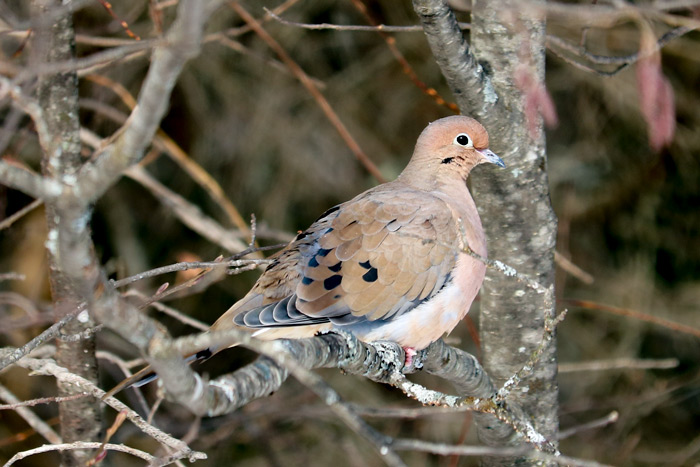
A mourning dove in the trees.
Mourning Dove Migration
Mourning doves are residents to long-distance migrants. These birds will remain over the winter but may move south from the north during the fall months.
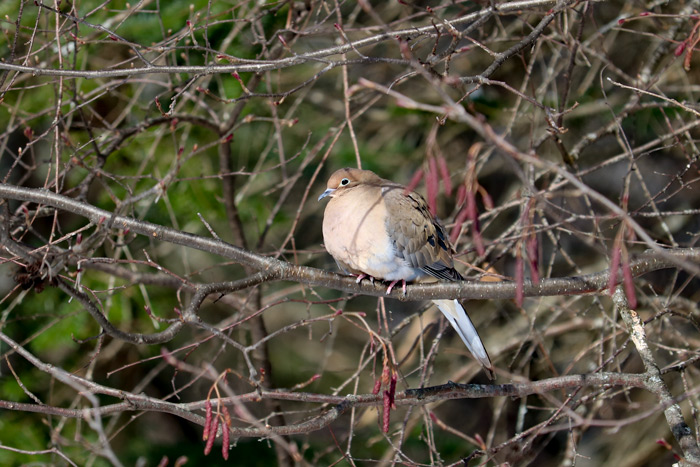
A mourning dove sunning itself.
I hope you have enjoyed learning about the mourning dove and thank you for reading.
Laura,
Thanks for sending me information on the mourning doves, very interesting reading. I did not know much about them.
I have not seen them lately, they must be mating, but I know about their mating calls. They are pretty noisy. They love to make their nest in my skylight window in my laundry room.
Sharon
Your information on the morning doves was indeed quite helpful but I have 2 (I assume babies) although they have a lot of feathers. These two have been sitting under a bush next to my front porch for two days. I saw the mother on the first morning but not since. I put out water but it doesn’t appear they are drinking and they do not hunt food. I am worried about them.
Hi Anita,
Thank you for your kind words regarding my post. In regard to your mourning dove fledglings, you may want to go ahead and contact a local rehabber, state wildlife agency, or veterinarian. They should be able to give you proper advice and possible steps to take, in order to ensure the well-being of these birds. Please let me know what happens. Take care, Laura
I have had Mourning Doves around my house or several years. They are beautiful and graceful but annoying with the early morning wake-up coo-ing. At 6:00 am on the nose it starts. Drives me up the wall. Funny….. I did not notice it til retired. .LOL
Hi Mary,
Oh, my! Yes, the birds, in general, this spring and summer have had no concern for our getting any sleep in the morning! It has been too hot to keep the windows closed, so I suppose we will have to endure their shenanigans for a few more weeks. There seems to be a contest between the mourning doves and robins as to who can be the loudest. Well, good luck to you and I hope you will be able to enjoy your mourning doves at a more convenient time during the day. Take care, Laura
Hey I have a mourning dove she must had fallen out the nest I saw her all day walking around , at the end of day I walked by her she did try to run or anything she was so weak. That night I gave her lots of water n hope she’d make it till morning, then I researched her about baby food to give to this bird. So I scrambled 2 eggs raw mixed in oatmeal, cornmeal and after week or so ground eggshells in her mix, now she only eats,I let her outside and she comes back every day. I felt so bad I couldn’t find her before big storm. So I kept her inside last night. She really likes me too like her mommy. But it’s about time she can feed herself , I just want to her her flyaway not only walk I’ve seen some ok flies, but they never went up wards. That’s where I’m at
Hi Julee, Well, it sounds like you have been doing a great job. Perhaps you can try to contact a local rehabilitator for a few more helpful tips to help your bird to find its way back to nature. Good luck to you, Laura
Hello,
Around 5 weeks ago, August 10 to be exact, I noticed a nest on an air conditioner in an upstairs spare bedroom. The mourning doves have been taking turns incubating the two eggs. I’ve witnessed the “changing of the guard” several times now. These doves still are faithfully sitting on those eggs 24/7 for over 5 weeks now. Can anyone offer some insights? It’s remarkable and quite inspiring and very touching to witness such dedication!
We have many mourning doves visit us every day. They usually eat what has fallen from our feeders from the many cardinals. Bluejays, chickadees and squirrels who can leave a mess behind. Today we noticed around 30 doves all perched in the big tree outside our window and they were there for a couple of hours. As the weather is getting colder we have noticed an increase of birds everyday.
I’m sure your mourning doves are thankful for the extra calories you are providing them in these cold temperatures. Thank you for sharing and I hope you continue to enjoy your avian visitors!
Trying to feed the mourning doves the crows/blackbirds seem to dominate the food! Any suggestions?
Hi, Don,
It seems your situation will most likely need to be addressed with a multipronged approach. Crows are quite intelligent and can be difficult to discourage from visiting bird feeders. In order to deter your unwanted crow and blackbird visitors from dominating the area, perhaps you can try hanging feeders for the smaller birds only. Some feeders are designed specifically to not allow large birds to access the food. Also, clean up any seed spills often so that the crows are not attracted to the area. Perhaps you can try implementing a decoy of some kind in order to scare these birds off. This can include several things such as hanging shiny objects in your yard or placing an owl decoy nearby. As you may know, owls are a natural enemy of these birds. As a last resort, you may want to bring your feeders in for a few days and see if they will eventually move on. I know how frustrating this can be as you would like to see the mourning doves and other birds enjoy their time at the feeders. Please let me know how you make out as I’m sure other readers would like to find out solutions to this problem as well. Take care, Laura
Nice site! Just a few days ago, a mourning dove flew into my backyard, picked up a twig, and then flew off again! That happened quite a few times.
Thank you, I’m glad you are enjoying my blog! It seems you may be watching a mourning dove in the midst of constructing a nest – how exciting!